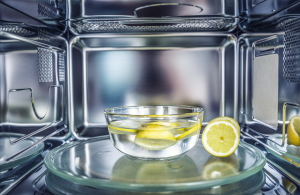We all like our kitchens to be spick and span after we finish cooking, but it’s easy to forget some of our most used appliances need a good clean. Microwaves are notorious for being the forgotten appliance to clean, and can gather grease and grime with plenty of use. There’s nothing worse than opening your microwave to find a food explosion from the night before or a foul smell from food build up.
Cleaning your microwave doesn’t have to be a begrudging task and doesn’t take long to clean at all. We have put together a quick guide to help keep your microwave clean using simple cleaning methods without the harsh chemicals and cleaning products.
How often should you clean a microwave?
Ideally your microwave should be cleaned once a week if you’re using it daily or multiple times a day. You can give it a quick wipe down after each use as well to make sure you’re not letting grease or odours build up. A wet cloth or paper towel is the easiest way to give it a wipe so your morning tea or coffee isn’t tasting and smelling like last night’s lasagne.
There are several reasons why you should consistently clean your microwave. Like with any other appliance, not regularly maintaining your microwave can end up making it work less effectively and could void your warranty if you need to send it back for a manufacturing fault. Fat and grease are also likely to become more difficult to scrub off as they dry and harden and can cause bacteria to grow.
Best methods to clean your microwave
A great way to prevent food splatter to begin with is to place a piece of paper towel or a plate over the dish you’re cooking. This can create a barrier between the food and microwave. But if there is a spill – which inevitably happens – it’s best to catch them as soon as they happen so there’s less build up over time. If you have had a build-up of spills, here are a couple of simple cleaning methods:
Vinegar and lemon method

This method is good for a quick clean of a small build-up of grime in the microwave.
- Pour a couple of tablespoons of vinegar or half a lemon into a bowl of water.
- Place the bowl in the microwave and run it on high for three minutes until the water in the bowl is boiling.
- Once the microwave has filled with steam and the timer has gone off, leave the bowl in there for another 3-5 minutes without running the microwave. This will allow the steam to loosen any residue inside the microwave.
- Open the door, carefully remove the bowl, and wipe away the residue with a damp cloth or paper towel.
Baking soda and vinegar method
For a deeper clean and tougher stains, another great cleaning method is a mixture of baking soda and vinegar.
- Mix 1-2 tablespoons of baking soda and vinegar in a bowl. Gradually add the vinegar until it reaches a paste consistency. Add more of one ingredient or the other until you reach a paste.
- Spread the mixture on the inside of the microwave and on the turntable plate.
- Leave for 10-15 minutes or until the paste has hardened.
- Scrape off the paste and use a wet cloth to wipe down any residue and to remove any excess hardened paste.
Easiest types of microwaves to clean
Compared to conventional microwaves, flatbed microwaves are easier to clean because they don’t have a bulky turntable that you need to wash separately. However, these tend to be more expensive to buy than models with a turntable. Many microwaves also come with features aimed to make cleaning up quicker and simpler. Certain LG models, for example, contain an Anti-Bacterial EasyClean interior coating that’s claimed to get rid of up to 99.99% of harmful bacteria on the surface. Several Panasonic microwaves, including the NN-CS89L (pictured), alternatively offer automatic cleaning programs that typically use steam to moisten any fat or grease inside the appliance, making it easier to wipe away.
Original Author: Tahnee-Jae Lopez-Vito


Share this article